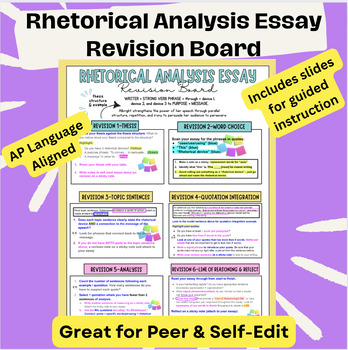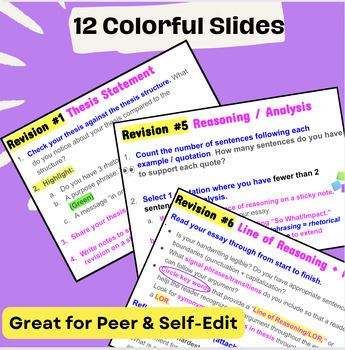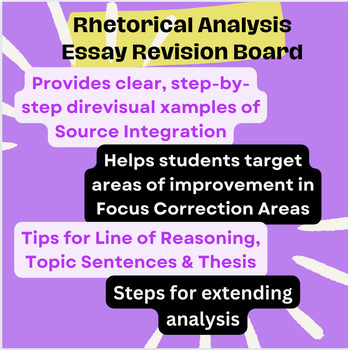Rhetorical Analysis Essay Revision Board Activity - AP Language Printable
- Google Drive™ folder

Description
Looking for a way to support students in targeted, actionable rhetorical analysis essay revision? This Revision Board activity takes students through targeted focus correction areas, helping students "zone in" on rhetorical essay "must-haves." By working through a colorful visual "Revision Board," students can self-edit independently with clear focus and outcomes towards a revised essay. This activity works equally as well with a guided whole-class revision instruction using the accompanying slides. Another effective way to use the Revision Board is in a Peer-Editing session. It's a great independent activity (either digital or printed) as well as opportunities for peer-to-peer discussion of the rhetorical analysis essay. This Revision Board looks beautiful printed in color. It's also a great visual in the classroom or for laminated copies at each table while students are writing the essay.
The Revision Board action steps ask students to highlight in different colors their sources to ensure students embed evidence from the text and connect text to analysis of rhetorical choices/devices. The Revision Board also prompts students to focus in on quotation integration by looking at signal phrases to seamlessly embed evidence into their commentary. Slides specific to thesis development help students isolate parts of the color-coded thesis statement to ensure their thesis contains a clear message, purpose, and focus on rhetorical choices/devices. Thesis statement examples are included.
Check out mySynthesis Essay Revision Board!
Earn free TPT Credit!! Offer feedback by:
- Going to your "My Purchases" page to find the "Provide Feedback" button next to each purchase. Follow the link to offer a rating and leave a comment for the product.
- Each time you give Feedback, TPT awards you credit that you can use to lower the cost of future purchases.
- I value your feedback. I am continually improving and developing new resources based on feedback from the TPT community. Thank you!
Follow me by clicking the GREEN Star under my store name. Be the first to know about new products and promotions.
Follow on Instagram
Check out my blog with teaching strategies
Check out my YouTube Channel for video lessons
Check out these discourse resources to level up engagement in your classroom:
- Probing Questions Speed Dating
- Discourse Builder Discussion Roundtable / Close Reading Activity
- Questions Stems by Question Type One-pager
- Progressive Questioning PD Workshop
Check out these resources to engage students in Debate:
- Freedom v. Safety Debate
- Growth Mindset Debate
- Who Gets the Heart Debate
- Debate Template/Slides for In-person & Digital Debates
- Full Debate Bundle Adaptable for all levels/grades + ESL
Check out these Argument Writing Resources:
- AP Language Argument Essay Step-by-Step Writing Guide
- Rhetorical Claims & Appeals Bundle
- Argument Essay Slides
- Ethos, Pathos, Logos Slides
- AP Language Exam Overview & Study Guide with Links
- Argumentative Writing Folder
- Argument Writing Stems Handout with Counter-rebuttals
- “Unknown” AP Lang Argument Prompt Essay Organizer Kit
- “Overrated AP Lang Argument Prompt Essay Organizer Kit + Line of Reasoning
Check out these listings to boost your students’ engagement with Rhetorical Analysis
Read Like a Writer - Rhetorical Analysis Kit
AP Lang Rhetorical Analysis Essay Reflection Tool
Rhetorical Device BIG Slide Deck
Rhetorical Claims & Appeals Bundle
Preparing your students for AP / SAT Multiple Choice Exams? Drive home strategies through these resources that get students ENGAGED with test preparation.
- Multiple Choice READING Questions Video Guide + Scaffolded Notes
- Multiple Choice WRITING Questions Video Guide + Scaffolded Notes
- AP Lang Multiple Choice EXPERT LESSON Group Activity
- Multiple Choice WRITING Slides: Sentence Combining & Organization Questions
- Multiple Choice Strategies POWERPOINT - AP/SAT/PSAT/MCAS all subjects
- AP Lang Multiple Choice WRITING questions with VIDEO tutorials
- Multiple Choice READING questions GROUP SOLVE activity (AP Lang/SAT/PSAT)
- Multiple Choice Strategy Mini Cards
Follow my TPT store for sales & new products. Thank you for leaving a review!





